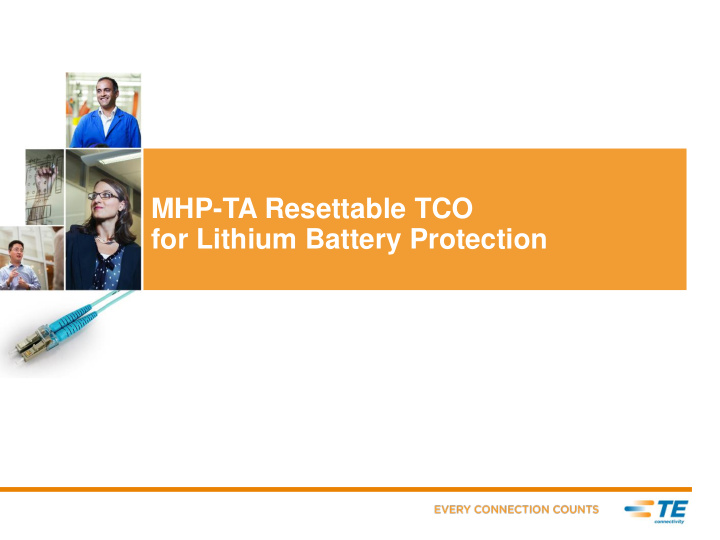



MHP-TA Resettable TCO for Lithium Battery Protection
Lithium Cell Protection Device Requirements are Changing Higher cell capacities & larger cell surface areas • Lower thermal cut-off temperatures (<90C) required • Improved margin of safety needed Higher battery discharge rates • Hold currents above 6A required • Multiple series and parallel pack configurations Small & thin protection devices required 2 TE Connectivity Confidential & Proprietary. Do not reproduce or distribute.
MHP-TA Resettable Thermal Cut-Off (TCO) What is the MHP-TA Device? Metal Hybrid PPTC - Thermal Activation Device • Combines a Polymer PTC with a Bi-metal in parallel • Over-temperature protection device • Resettable activation Application: • Protection for rechargeable Lithium cells Lithium Polymer Li-ion Prismatic • Other applications that require a resettable TCO • Resistance or laser welded to cell terminals • Nickel lead extensions and taping also available 3 TE Connectivity Confidential & Proprietary. Do not reproduce or distribute.
The MHP-TA Technology Principle A hybrid circuit protection device that combines a Polymer PTC (polymeric positive temperature coefficient) with a Bi-metal in parallel The MHP-TA technology incorporates the best features of a bimetal breaker and PPTC and reduces the downside of each technology. Advantage Disadvantage ・ Low resistance ・ Non-Latching ・ High operating current Bimetal ・ Mechanical contact ・ Good temperature sensing Combine ・ Latches ・ Thermal derating size for PPTC operating current ・ No mechanical contact Metal Hybrid PPTC (MHP) – Thermal Activation 4 TE Connectivity Confidential & Proprietary. Do not reproduce or distribute.
MHP-TA Technology Leverages TE Strengths TE strengths in high precision, miniature molded connector products TE extensive experience in polymer PTCs and battery circuit protection RF Switch Plug TE Connectivity Core Competencies 2.00 (0.079) • Precision molding A 26 (1.024) A • Precision stamping A 2.88 (0.113) 2.00 (0.079) • Unit : mm (inch) Miniaturization Unit : mm (inch) 0.95 (0.037) • High speed assembly 5 TE Connectivity Confidential & Proprietary. Do not reproduce or distribute.
MHP-TA Application Cell protection – added directly to the Li-polymer cell Resistance or laser welded to cell terminals Can also be added to prismatic cells Nickel lead extensions and taping also available 6 TE Connectivity Confidential & Proprietary. Do not reproduce or distribute.
MHP-TA Technology Solves These Problems Customer Problem General Design Problem Ultimate Solution Solution Lithium cells need Thermal Cut-off One time use TCOs over temperature (TCO) (thermal fuse) can protection have nuisance trips Resettable thermal Thin PCs and Traditional protection tablets…. protection devices device in a low capable of higher profile package 1.Need higher hold currents (>6A) (MHP-TA) capacity cells than are not small or thin enough a smart phone 2.Generate higher discharge currents 7 TE Connectivity Confidential & Proprietary. Do not reproduce or distribute.
MHP-TA Operating Principle Normal Condition ① Contact • Silver contacts carries the current [Rc<<Rptc] PPTC Fault Condition ② Contact • Contact opens • Current goes through PPTC PPTC • Current heats up the PPTC >>>> Resistance increases Result: Tripped PPTC heats the bimetal and keeps it open during a fault condition 8 TE Connectivity Confidential & Proprietary. Do not reproduce or distribute.
Example of Resistance vs. Temperature Curve Contact open temperature test Spec: Contact open at 77 ℃ <Test condition> Rise from 20 ℃ to 120 ℃ and go back to 20 ℃ Temperature step: 2 ℃ 77 ℃ contact open device Hold time: 1min 1.0E+02 1.0E+01 Resistance(ohm) 1.0E+00 Contact open 77 ℃ Reset Open 1.0E-01 1.0E-02 1.0E-03 20 40 60 80 100 120 Temperature (℃) Contact opens at 77 ℃ 9 TE Connectivity Confidential & Proprietary. Do not reproduce or distribute.
Typical Hold Current vs. Temperature Performance MHP-TAM15 – High Current Series 10 TE Connectivity Confidential & Proprietary. Do not reproduce or distribute.
Typical Hold Current vs. Temperature Performance MHP-TAM6 – Low Current Series 11 TE Connectivity Confidential & Proprietary. Do not reproduce or distribute.
MHP-TA Provides Excellent Cycle Life - Durability Cycle test Spec: <Test condition> Resistance: < 5 mohm Power supply: Open / close cycle: No contact weld DC9V/25A (DC 9 V / 25 A 6000 cycles) Temperature: 25 ℃ No resistance change Cycle time: 6,000 cycle 5 Initial resistance : Typ. 2.50 mohm 4 Resistance(mohms) 3 2 1 No contact weld 0 0.1 1 10 100 1000 10000 After 6000 cycles Number of Cycles 12 TE Connectivity Confidential & Proprietary. Do not reproduce or distribute.
Product Line-up MHP-TAM6 – Low Current Series MHP-TAM15 – High Current Series 13 TE Connectivity Confidential & Proprietary. Do not reproduce or distribute.
MHP-TA Technology Summary Combines a Polymer PTC with a Bi-metal in parallel Over-temperature protection device Resettable activation Device Ratings 9VDC Low current and high current versions TCO: 72 ° C, 77 ° C, 82 ° C, 85 ° C, 90 ° C UL Recognized Ideal for Lithium polymer battery designs that need a small thermal cut-off (TCO) device that can handle higher currents Resettable device helps eliminate “nuisance trip” issues occurring in non-resettable thermal fuses or TCOs 14 TE Connectivity Confidential & Proprietary. Do not reproduce or distribute.
Recommend
More recommend